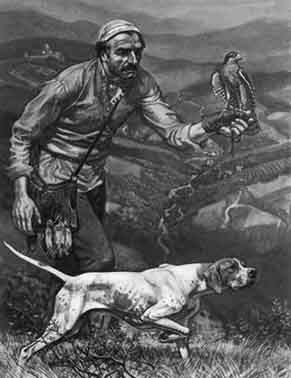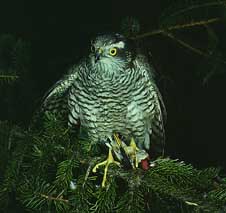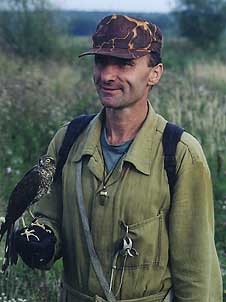Sparrow hawk
(Accipiter nisus L.)
Mykola Rud'
Translation in Engl.: Yevheniia Mikheenko
Illustration picture: Vadim Gorbatov;
Foto: Yuri Samilak;
Mykola Rud;
From ancient times, in the Kyivan Rus, the bird was commonly called perepelyatnyk (from “perepel” - quail) due to its predisposition to prey on quail during the autumn migration. As Slavonic culture and language filtered into Moskovia, this name replaced the various local Turko-Ugro-Finnish equivalents and soon became firmly integrated in the Moskovian dialect of the Kyivan Rus language.
Czechs and Slovaks call the small and agile bird of prey krahujec, which clearly shows etymological link with the ancient Ukrainian synonym krahuj or krahulec (from Grinchenko dictionary). Ukrainian priority in the formation of archaic, ancient terminology of falconry in the Slavonic languages is also highlighted by the similarity of the Ukrainian name of sparrow hawk, krahuj, with the Kazakh (Turkic) kyrhyj. In English the bird is called a sparrow hawk, in German - sperber.

In the Caucasus, where it is particularly popular as a hunting bird, its name is mimino. After the hunting season, a widespread practice is to release trained birds into the wild. Occasionally the very skilled ones, which have demonstrated exceptional qualities, are kept over winter. In such cases, the owner has to not only feed, but also care for the bird until the following hunting season. Such birds are called kapoeti (kypoeti).
Winter hunting with mimino, unlike hunting with goshawk (Accipiter gentilis L.), especially at low temperatures, is rather problematic due to its subtlety and lack of adequate quarry. In the cold season, among the potential game of sparrow hawk for an amateur falconer, of interest are only partridge and woodpigeons.
In summer, as cherries begin to ripen, the sparrow hawk has found use in warding off birds such as starlings and thrushes, which can significantly reduce the harvest as well as damage the crop. The use of the sparrow hawk in this case is well justified and extremely profitable financially. Specialist findings have indicated that migrating flocks are capable of destroying a significant proportion of cherry and garden strawberry crops in a matter of hours. Thrushes pose a particular danger to the grape harvest in the autumn. Mixed flocks numbering many thousands are capable of attacking vineyards and causing great financial losses to private and specialised farms. The large areas of vineyards decrease the chances of effectively scaring off the birds by any artificial means. However, under these conditions the use of only several trained sparrow hawks is fairly effective.
A variety of methods of scaring off or destroying destructive flocks to protect vineyards were used throughout the decades, but none proved particularly effective. However, research has shown that real benefit can be obtained solely by the use of small, manoeuvrable, swift birds of prey. Just the appearance of a sparrow hawk, hobby (Falco subbuteo L.) or merlin (Falco columbarius L.) can plunge huge flocks into state of mass panic, which with a terrible clamour suddenly fly up into the air and vanishes. This method of dealing with flocks is the most ecological and humane way, as it eliminates the necessity to kill large numbers of birds. Characteristically, when a hunting bird is cast off a few times at flocks in the same place, the area is avoided for a considerable period of time even by the “scouts” of the flocks*.
In the wild, during winters with little snow, sparrow hawks stay close to grassy meadows - the feeding ground of woodpigeons and other small background species. There the birds of prey hunt until massive snowfalls.
Sparrow hawks kept indoors for long period undergo a moulting. For this reason it is rare for falconers to keep sparrow hawks for a number of seasons.

The species is widespread in Europe and Asia (except the tundra zone), and in North Africa. Sparrow hawks are found across Ukraine as sedentary birds. Recently, tagged solitary individuals were seen residing near Kyiv even in very cold winters.
Among classic hunting birds the sparrow hawk is considered to be the least popular and productive. However, according to renowned experts (Demenchuk G. A.), if trained by a highly qualified falconer, the bird is capable of tackling almost the entire range of potential feathered quarry taken goshawk **. Also, it is worth noting that the bird is capable of quick domestication and obediently performs learned commands. Among the Caucasus falconers white sparrow hawks are especially prized. At falconry contests, at equal ratings with other contestants, they achieve top awards for their spectacular performance.
In raising of the sparrow hawk it is rather difficult to keep the bird in required state for a long time. This is due to subtle structure of the sparrow hawk in comparison with its much stronger relative. Clearly, for this reason in Ukraine the bird is much less common as a hunting bird than goshawk. Preference is given to goshawk due to a higher level of unification in orientation on quarry and much greater hunting potential.
Still, among Kyiv hawkers there are amateurs who demonstrate good results in prolonged keeping and hunting with krahuj. One of them rescued a bird in a terrible state with numerous wounds. The bird’s skin near the crop was ripped, which in absence of surgical intervention could equal to a death sentence. However, the amateur succeeded in applying several stitches to the wounds and keeping the bird on appropriate diet for a few weeks. After a difficult period of treatment, the bird not only regained health, but was trained and became and excellent hunter. After training it is capable of successfully taking game from the pointer, which he feels as his partner.
The keeping of sparrow hawk, unlike the keeping of goshawk, has significant peculiarities:

From the1960s, keeping of sparrow hawks by local falconers of Europe and America became rather widespread and popular. The problem of conducting open-air training in an urban environment due to high density of buildings, lack of open space and inadequate response of neighbours lead to training the birds in rented sports halls or other premises suited to the purpose. Falconers usually hunt without leaving the city. To avoid conflicts with the government and local residents, the birds are flown at sparrows, woodpigeons and turtledoves through an open window of the car. At a successful cast the sparrow hawk with its quarry is quickly collected, while during flight the owner leaves the car and calls the bird onto the glove. Many subtle details which can be noted by thoughtful owners during training sessions allow a highly successful realisation of sparrow hawk’s biological potential, provide an excellent leisure activity and a lot of enjoyment coming from communication with the bird and successful casts at hunting.
________
* At this moment no practical means of dealing with this phenomenon have been ascertained, except propositions of giving permission for hunting of some birds. At private and specialised farms thrushes, starlings and other species can destroy or damage up to 70% of the harvests of cherries, raspberries, etc. In many regions the birds completely destroy strawberry crops. During years of low ash-berry yields, which in autumn is the main food within the northern part of the areal of fieldfares (Turdus pilaris L.), birds which migrate into Western Europe can spoil up to 30% of apples and pears. Covering the trees with special nets to protect the harvest is ineffective – it only works against sparrows and starlings. Thrushes show amazing ingenuity in finding holes to get at the berries. One of perspective ways of fighting harmful flocks is the cultivation of birds of prey. Unfortunately, at this stage this direction is not being developed in Ukraine due to lack of land privatisation and, consequently, of landowners really interested in preserving their crops.
** Of course, hunting hare, pheasant and other massive quarry is out of question even with the large females of sparrow hawk.